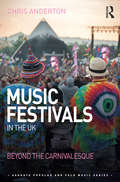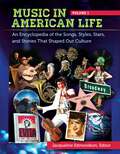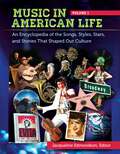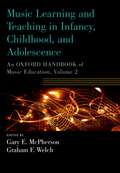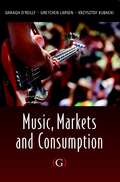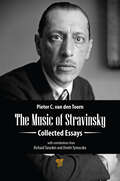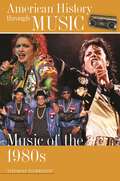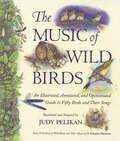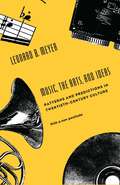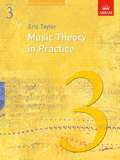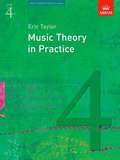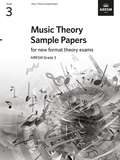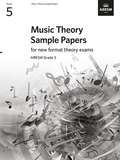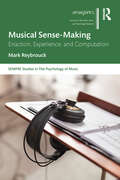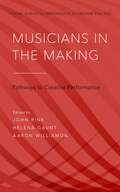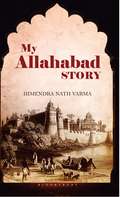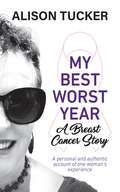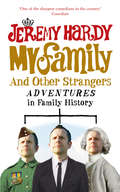- Table View
- List View
Music Festivals in the UK: Beyond the Carnivalesque (Ashgate Popular and Folk Music Series)
by Chris AndertonThe outdoor music festival market has developed and commercialised significantly since the mid-1990s, and is now a mainstream part of the British summertime leisure experience. The overall number of outdoor music festivals staged in the UK doubled between 2005 and 2011 to reach a peak of over 500 events. UK Music (2016) estimates that the sector attracts over 3.7 million attendances each year, and that music tourism as a whole sustains nearly 40,000 full-time jobs. Music Festivals in the UK is the first extended investigation into this commercialised rock and pop festival sector, and examines events of all sizes: from mega-events such as Glastonbury Festival, V Festival and the Reading and Leeds Festivals to ‘boutique’ events with maximum attendances as small as 250. In the past, research into festivals has typically focused either on their carnivalesque heritage or on developing managerial tools for the field of Events Management. Anderton moves beyond such perspectives to propose new ways of understanding and theorising the cultural, social and geographic importance of outdoor music festivals. He argues that changes in the sector since the mid-1990s, such as professionalisation, corporatisation, mediatisation, regulatory control, and sponsorship/branding, should not necessarily be regarded as a process of transgressive 'alternative culture’ being co-opted by commercial concerns; instead, such changes represent a reconfiguration of the sector in line with changes in society, and a broadening of the forms and meanings that may be associated with outdoor music events.
Music in American Life [4 volumes]: An Encyclopedia of the Songs, Styles, Stars, and Stories That Shaped Our Culture [4 volumes]
by Jacqueline EdmondsonA fascinating exploration of the relationship between American culture and music as defined by musicians, scholars, and critics from around the world.Music has been the cornerstone of popular culture in the United States since the beginning of our nation's history. From early immigrants sharing the sounds of their native lands to contemporary artists performing benefit concerts for social causes, our country's musical expressions reflect where we, as a people, have been, as well as our hope for the future. This four-volume encyclopedia examines music's influence on contemporary American life, tracing historical connections over time.Music in American Life: An Encyclopedia of the Songs, Styles, Stars, and Stories That Shaped Our Culture demonstrates the symbiotic relationship between this art form and our society. Entries include singers, composers, lyricists, songs, musical genres, places, instruments, technologies, music in films, music in political realms, and music shows on television.
Music in American Life [4 volumes]: An Encyclopedia of the Songs, Styles, Stars, and Stories That Shaped Our Culture [4 volumes]
A fascinating exploration of the relationship between American culture and music as defined by musicians, scholars, and critics from around the world.Music has been the cornerstone of popular culture in the United States since the beginning of our nation's history. From early immigrants sharing the sounds of their native lands to contemporary artists performing benefit concerts for social causes, our country's musical expressions reflect where we, as a people, have been, as well as our hope for the future. This four-volume encyclopedia examines music's influence on contemporary American life, tracing historical connections over time.Music in American Life: An Encyclopedia of the Songs, Styles, Stars, and Stories That Shaped Our Culture demonstrates the symbiotic relationship between this art form and our society. Entries include singers, composers, lyricists, songs, musical genres, places, instruments, technologies, music in films, music in political realms, and music shows on television.
Music Learning and Teaching in Infancy, Childhood, and Adolescence: An Oxford Handbook of Music Education, Volume 2 (Oxford Handbooks)
by Graham F. Welch Gary E. McPhersonMusic Learning and Teaching in Infancy, Childhood, and Adolescence is one of five paperback books derived from the foundational two-volume Oxford Handbook of Music Education. Designed for music teachers, students, and scholars of music education, as well as educational administrators and policy makers, the second book in this set explores a broad array of key issues, concepts, and debates related to music learning and teaching in three phases of a child's development. The first section provides an expanded view of infancy and early childhood, embracing a key theme that most young children's early music-making is improvised and used to communicate with others and the self. These chapters demonstrate the importance of "motherese" or "parentese" to young children's overall development, the extraordinary diversity and richness of children's early musical engagement, and how this can be viewed as a resource for further learning. The second section is devoted to the learning and teaching of music during the middle years of childhood, when music is often a mandated part of the school curriculum. While recognizing the enormous cultural and national differences, chapters in this section give an overview of many varied and innovative forms of musical learning and teaching globally. The authors address issues related to the types of teachers who provide music instructions to children internationally, how they were educated and trained, and how various nations organize their curriculum in ways that provide children with access and opportunities to engage with music in the classroom. The third section focuses on the musical experiences and development of adolescents aged 12 to 18. These chapters explore the role of music in the lives of young people-including how they use and relate to music, how music educators can best meet students' needs, and the types of musical engagement that can either empower or disempower students through involvement in school music. Contributors Mayumi Adachi, Randall Everett Allsup, Janet R. Barrett, Margaret S. Barrett, Brydie-Leigh Bartleet, Lily Chen-Hafteck, Richard Colwell, Sharon G. Davis, George M. DeGraffenreid, Steven C. Dillon, Magne I. Espeland, Martin Fautley, Eve Harwood, Lee Higgins, Beatriz Ilari, Neryl Jeanneret, Chee-Hoo Lum, Stephen Malloch, Esther Mang, Kathryn Marsh, Gary E. McPherson, Oscar Odena, Chris Philpott, S. Alex Ruthmann, Eric Shieh, Gary Spruce, Johannella Tafuri, Sandra E. Trehub, Colwyn Trevarthen, Kari K. Veblen, Graham F. Welch, Heidi Westerlund, Jackie Wiggins, Ruth Wright, Susan Young
Music Learning and Teaching in Infancy, Childhood, and Adolescence: An Oxford Handbook of Music Education, Volume 2 (Oxford Handbooks)
Music Learning and Teaching in Infancy, Childhood, and Adolescence is one of five paperback books derived from the foundational two-volume Oxford Handbook of Music Education. Designed for music teachers, students, and scholars of music education, as well as educational administrators and policy makers, the second book in this set explores a broad array of key issues, concepts, and debates related to music learning and teaching in three phases of a child's development. The first section provides an expanded view of infancy and early childhood, embracing a key theme that most young children's early music-making is improvised and used to communicate with others and the self. These chapters demonstrate the importance of "motherese" or "parentese" to young children's overall development, the extraordinary diversity and richness of children's early musical engagement, and how this can be viewed as a resource for further learning. The second section is devoted to the learning and teaching of music during the middle years of childhood, when music is often a mandated part of the school curriculum. While recognizing the enormous cultural and national differences, chapters in this section give an overview of many varied and innovative forms of musical learning and teaching globally. The authors address issues related to the types of teachers who provide music instructions to children internationally, how they were educated and trained, and how various nations organize their curriculum in ways that provide children with access and opportunities to engage with music in the classroom. The third section focuses on the musical experiences and development of adolescents aged 12 to 18. These chapters explore the role of music in the lives of young people-including how they use and relate to music, how music educators can best meet students' needs, and the types of musical engagement that can either empower or disempower students through involvement in school music. Contributors Mayumi Adachi, Randall Everett Allsup, Janet R. Barrett, Margaret S. Barrett, Brydie-Leigh Bartleet, Lily Chen-Hafteck, Richard Colwell, Sharon G. Davis, George M. DeGraffenreid, Steven C. Dillon, Magne I. Espeland, Martin Fautley, Eve Harwood, Lee Higgins, Beatriz Ilari, Neryl Jeanneret, Chee-Hoo Lum, Stephen Malloch, Esther Mang, Kathryn Marsh, Gary E. McPherson, Oscar Odena, Chris Philpott, S. Alex Ruthmann, Eric Shieh, Gary Spruce, Johannella Tafuri, Sandra E. Trehub, Colwyn Trevarthen, Kari K. Veblen, Graham F. Welch, Heidi Westerlund, Jackie Wiggins, Ruth Wright, Susan Young
Music, Markets And Consumption
by Daragh O'Reilly Gretchen Larsen Krzysztof KubackiThis is one of the first academically rigorous texts covering the whole topic of popular music as a major market, and its marketing and in the contemporary connected world. There are books written by popular music commentators but Music, Markets and Consumption aims to give a fully international and scholarly analysis integrating the unique popular music sector both within arts marketing and current marketing and consumption theories. It gives the student and specialist a full overview and coverage of music, marketing and cultural policy, and the emerging academic study of the sector. It will collect and analyse a range of key issues in the field including: * The increasing engagement with marketing and consumer studies theory; * The analysis of music as ‘product’; * The economics, branding and commercialisation of music globally; * The impact of technology and evolution of venues on music consumption; * The consumer- fans and fandom; * The fast developing international literature. It is a much needed new perspective for students and researchers of music and arts marketing, cultural consumption and consumption theories and those in the fields of Marketing, Arts, Music and Cultural Studies. The book is also essential reading for those professionally involved in music marketing and cultural policy.
The Music of Stravinsky: Collected Essays
by Pieter C. van den ToornThe most celebrated of Western composers in the twentieth century, Igor Stravinskymay have been the greatest as well. Stretching across forty or so years, the essays in this volume address the dynamics of Igor Stravinsky’s music from a variety of analytical, critical, and aesthetic angles. Underscored are the features of melody, harmony, rhythm, and form that would remain consistently a part of Stravinsky’s oeuvre regardless of the changes in orientation from the Russian period to the neoclassical and the early serial. The Rite of Spring (1913), Les Noces (1917–23), the Symphony of Psalms (1930), and the Symphony in Three Movements (1945) are discussed in detail, as are many of the circumstances attending their conception. Other concerns include the composer’s "formalist" aesthetics and the strict performing style he pursued as an interpreter and conductor of his music.
The Music of Stravinsky: Collected Essays (Music Since 1900 Ser.)
by Pieter C. van den ToornThe most celebrated of Western composers in the twentieth century, Igor Stravinskymay have been the greatest as well. Stretching across forty or so years, the essays in this volume address the dynamics of Igor Stravinsky’s music from a variety of analytical, critical, and aesthetic angles. Underscored are the features of melody, harmony, rhythm, and form that would remain consistently a part of Stravinsky’s oeuvre regardless of the changes in orientation from the Russian period to the neoclassical and the early serial. The Rite of Spring (1913), Les Noces (1917–23), the Symphony of Psalms (1930), and the Symphony in Three Movements (1945) are discussed in detail, as are many of the circumstances attending their conception. Other concerns include the composer’s "formalist" aesthetics and the strict performing style he pursued as an interpreter and conductor of his music.
Music of the 1980s (American History through Music)
by Thomas HarrisonBeyond coverage of mainstream 80s music, such as "hair band" hard rock, pop, new wave, and rap, this compilation of essential musical artists also covers genres like classical, jazz, outlaw country, and music theater.Popular music in the United States during the 1980s is well known for imports from abroad, such as A-ha, Def Leppard, Falco, and Men at Work, as well as homegrown American rock acts such as Guns 'N Roses, Huey Lewis and the News, Bon Jovi, and Poison. But there were many other types of genres of music that never received airplay on the radio or MTV that also experienced significant evolutions or growth in that decade.Music of the 1980s examines the key artists in specific genres of popular music: pop, hard rock/heavy metal, rock, and country. No other reference book for students has previously explored the surprisingly diverse categories of hard rock and heavy metal music with such detail and depth. Additionally, a chapter focuses on the prominent artists and composers of less-mainstream genres for specialized audiences, including music theater, jazz, and classical music.
The Music of Wild Birds: An Illustrated, Annotated, and Opinionated Guide to Fifty Birds and Their Songs
by Judy PelikanOne hundred years ago, F. Schuyler Mathews, an erudite naturalist and birder, theorized that birds sing first for love of music, and second for love of the lady. To expand on his theory, he actually scored the songs of birds in the wild. His charming text and bird-by-bird annotations were compiled into a guide called Field Book of Wild Birds and Their Music. This extraordinary work has now been lavishly illustrated and adapted for a new audience. Each bird is meticulously rendered by artist Judy Pelikan in full-color illustrations that feature not only the birds, but also their nests, eggs, and feathers. And every song is represented by its written musical score, which Mathews expertly explains in a way that both musicians and non-musicians can enjoy. As Mathews points out, the music of wild birds is everywhere--in poems, children's nursery songs, as well as in the works of the great composers: the Black-billed Cuckoo's call appears near the close of Beethoven's Pastoral Symphony; the Nashville Warbler's song is found in the opening bars of Rossini's Carovale, and the Meadowlark's song is remarkably like the first two bars of Alfredo's song in La Traviata. He reveals how a bird's character is reflected in its song: the Baltimore Oriole is a sharp-billed, sharp-witted character, and his remarks are as incisive and crisp as the toots of a steam whistle. And he reminds us of the words of our great poets--Wordsworth, Emerson, Sir Walter Scott--and their descriptions of the very same birds and their music. This classic, useful, and completely original guide will put a song into the heart of novice and experienced birder alike.
Music, the Arts, and Ideas: Patterns and Predictions in Twentieth-Century Culture
by Leonard B. MeyerMeyer makes a valuable statement on aesthetics, criteria for assessing great works of music, compositional practices and theories of the present day, and predictions of the future of Western culture. His postlude, written for the book's twenty-fifth anniversary, looks back at his thoughts on the direction of music in 1967.
Music, the Arts, and Ideas: Patterns and Predictions in Twentieth-Century Culture
by Leonard B. MeyerMeyer makes a valuable statement on aesthetics, criteria for assessing great works of music, compositional practices and theories of the present day, and predictions of the future of Western culture. His postlude, written for the book's twenty-fifth anniversary, looks back at his thoughts on the direction of music in 1967.
Music, the Arts, and Ideas: Patterns and Predictions in Twentieth-Century Culture
by Leonard B. MeyerMeyer makes a valuable statement on aesthetics, criteria for assessing great works of music, compositional practices and theories of the present day, and predictions of the future of Western culture. His postlude, written for the book's twenty-fifth anniversary, looks back at his thoughts on the direction of music in 1967.
Music, the Arts, and Ideas: Patterns and Predictions in Twentieth-Century Culture
by Leonard B. MeyerMeyer makes a valuable statement on aesthetics, criteria for assessing great works of music, compositional practices and theories of the present day, and predictions of the future of Western culture. His postlude, written for the book's twenty-fifth anniversary, looks back at his thoughts on the direction of music in 1967.
Music Theory In Practice, Grade 3 (PDF)
by Eric TaylorThe Music Theory in Practice series has helped more than one million musicians worldwide to learn about the notation and theory of music. Revised in 2008, this workbook remains the best way to prepare for ABRSM's Grade 3 Theory of Music Exam. Features a clear explanation of music notation, many worked examples and practice exercises, definitions of important words and concepts, specimen exam questions and helpful tips for students. As well as supporting the ABRSM Theory syllabus, this workbook also provides an excellent resource for anyone wishing to develop general music literacy skills.
Music Theory In Practice, Grade 4 (Music Theory In Practice (abrsm) Ser.)
by Eric TaylorThe Music Theory in Practice series has helped more than one million musicians worldwide to learn about the notation and theory of music. Revised in 2008, this workbook remains the best way to prepare for ABRSM's Grade 4 Theory of Music Exam. Features a clear explanation of music notation, many worked examples and practice exercises, definitions of important words and concepts, specimen exam questions and helpful tips for students. As well as supporting the ABRSM Theory syllabus, this workbook also provides an excellent resource for anyone wishing to develop general music literacy skills.
Music Theory Sample Papers [2020], ABRSM Grade 3
by AbrsmABRSM’s official Music Theory Sample Papers are essential resources for candidates preparing for our Music Theory exams. They provide authentic practice material and are a reliable guide as to what to expect in the exam.
Music Theory Sample Papers, ABRSM Grade 5: for new format Music Theory exams from 2020
by AbrsmABRSM’s official Music Theory Sample Papers are essential resources for candidates preparing for our Music Theory exams. They provide authentic practice material and are a reliable guide as to what to expect in the exam.
Musical Sense-Making: Enaction, Experience, and Computation (SEMPRE Studies in The Psychology of Music)
by Mark ReybrouckMusical Sense-Making: Enaction, Experience, and Computation broadens the scope of musical sense-making from a disembodied cognitivist approach to an experiential approach. Revolving around the definition of music as a temporal and sounding art, it argues for an interactional and experiential approach that brings together the richness of sensory experience and principles of cognitive economy. Starting from the major distinction between in-time and outside-of-time processing of the sounds, this volume provides a conceptual and operational framework for dealing with sounds in a real-time listening situation, relying heavily on the theoretical groundings of ecology, cybernetics, and systems theory, and stressing the role of epistemic interactions with the sounds. These interactions are considered from different perspectives, bringing together insights from previous theoretical groundings and more recent empirical research. The author’s findings are framed within the context of the broader field of enactive and embodied cognition, recent action and perception studies, and the emerging field of neurophenomenology and dynamical systems theory. This volume will particularly appeal to scholars and researchers interested in the intersection between music, philosophy, and/or psychology.
Musical Sense-Making: Enaction, Experience, and Computation (SEMPRE Studies in The Psychology of Music)
by Mark ReybrouckMusical Sense-Making: Enaction, Experience, and Computation broadens the scope of musical sense-making from a disembodied cognitivist approach to an experiential approach. Revolving around the definition of music as a temporal and sounding art, it argues for an interactional and experiential approach that brings together the richness of sensory experience and principles of cognitive economy. Starting from the major distinction between in-time and outside-of-time processing of the sounds, this volume provides a conceptual and operational framework for dealing with sounds in a real-time listening situation, relying heavily on the theoretical groundings of ecology, cybernetics, and systems theory, and stressing the role of epistemic interactions with the sounds. These interactions are considered from different perspectives, bringing together insights from previous theoretical groundings and more recent empirical research. The author’s findings are framed within the context of the broader field of enactive and embodied cognition, recent action and perception studies, and the emerging field of neurophenomenology and dynamical systems theory. This volume will particularly appeal to scholars and researchers interested in the intersection between music, philosophy, and/or psychology.
Musicians in the Making: Pathways to Creative Performance (Studies in Musical Performance as Creative Practice)
by John Rink, Helena Gaunt and Aaron WilliamonMusicians are continually 'in the making', tapping into their own creative resources while deriving inspiration from teachers, friends, family members and listeners. Amateur and professional performers alike tend not to follow fixed routes in developing a creative voice: instead, their artistic journeys are personal, often without foreseeable goals. The imperative to assess and reassess one's musical knowledge, understanding and aspirations is nevertheless a central feature of life as a performer. Musicians in the Making explores the creative development of musicians in both formal and informal learning contexts. It promotes a novel view of creativity, emphasizing its location within creative processes rather than understanding it as an innate quality. It argues that such processes may be learned and refined, and furthermore that collaboration and interaction within group contexts carry significant potential to inform and catalyze creative experiences and outcomes. The book also traces and models the ways in which creative processes evolve over time. Performers, music teachers and researchers will find the rich body of material assembled here engaging and enlightening. The book's three parts focus in turn on 'Creative learning in context', 'Creative processes' and 'Creative dialogue and reflection'. In addition to sixteen extended chapters written by leading experts in the field, the volume includes ten 'Insights' by internationally prominent performers, performance teachers and others. Practical aids include abstracts and lists of keywords at the start of each chapter, which provide useful overviews and guidance on content. Topics addressed by individual authors include intrapersonal and interpersonal dynamics, performance experience, practice and rehearsal, 'self-regulated performing', improvisation, self-reflection, expression, interactions between performers and audiences, assessment, and the role of academic study in performers' development.
Musicians in the Making: Pathways to Creative Performance (Studies in Musical Performance as Creative Practice)
Musicians are continually 'in the making', tapping into their own creative resources while deriving inspiration from teachers, friends, family members and listeners. Amateur and professional performers alike tend not to follow fixed routes in developing a creative voice: instead, their artistic journeys are personal, often without foreseeable goals. The imperative to assess and reassess one's musical knowledge, understanding and aspirations is nevertheless a central feature of life as a performer. Musicians in the Making explores the creative development of musicians in both formal and informal learning contexts. It promotes a novel view of creativity, emphasizing its location within creative processes rather than understanding it as an innate quality. It argues that such processes may be learned and refined, and furthermore that collaboration and interaction within group contexts carry significant potential to inform and catalyze creative experiences and outcomes. The book also traces and models the ways in which creative processes evolve over time. Performers, music teachers and researchers will find the rich body of material assembled here engaging and enlightening. The book's three parts focus in turn on 'Creative learning in context', 'Creative processes' and 'Creative dialogue and reflection'. In addition to sixteen extended chapters written by leading experts in the field, the volume includes ten 'Insights' by internationally prominent performers, performance teachers and others. Practical aids include abstracts and lists of keywords at the start of each chapter, which provide useful overviews and guidance on content. Topics addressed by individual authors include intrapersonal and interpersonal dynamics, performance experience, practice and rehearsal, 'self-regulated performing', improvisation, self-reflection, expression, interactions between performers and audiences, assessment, and the role of academic study in performers' development.
My Allahabad Story
by Himendra Nath VarmaMy Allahabad Story recollects the author's privileged childhood in a prominent family of the city he is obsessed with. He traces his growing years in the large middle class Kayastha family bringing out in amusing detail, some quaint social customs and traditions that existed half a century ago.The author wonderfully describes the changed complexion of the city with a tinge of despair. Life and times and what happened to Allahabad has been graphically described with nostalgia. An interesting account of an Irish resident brings out the social life that prevailed in Allahabad hundred years ago, interlaced beautifully between the English, Anglo-Indians and Indians.
My Best Worst Year: A Breast Cancer Story
by Alison Tucker‘Alison, I’ve got bad news.’The voice of the pathologist at the other end of the telephone confirmed for Alison Tucker the news no woman ever wants to hear: she had breast cancer.Once the shock had settled, Alison decided that she would take charge. Not only would she take ownership of the dreaded disease, but she would do so with a positive mindset and prepare herself as best she could for what was to come. She did detailed research and paid close heed to what she was told by others who had walked the path before her.As she navigated her way through surgery and the chemotherapy and radiotherapy that followed, Alison’s determination paid off. Not only did she make new friends, but she learnt valuable life lessons too: acceptance of the illness for what it was, the amazing impact of ongoing advances in medical science, and the importance of being able to ask for – and receive – help.In My Best Worst Year – A Breast Cancer Story Alison gives us an authentic account of her experience, offering insights and advice for others who might one day face the same diagnosis. You will accompany her on her highs, empathise with her lows, and be amused by humorous anecdotes along the way. Through the generous support of family and friends, she has amassed a collection of practical tips for both patients and supporters which she shares with open-hearted honesty.What to take to chemotherapy sessions.What to look for when choosing a wig.What side effects a person can expect when having the various types of cancer treatment.What to say, and what not to say, to a cancer patient.How to remove stress from a cancer patient’s life.What kind of gifts and gestures are most appreciated.Contrary to Alison’s expectations, her year of treatment turned out to be her best worst year. By telling her story, she underlines the importance of a positive attitude and hopes to show that a person can still lead a productive and enjoyable life even after being diagnosed with cancer.‘I learnt the power of gratitude, a learning that I will cherish forever and that I will draw on in no small measure in the good times and the bad.’
My Family and Other Strangers: Adventures in Family History
by Jeremy HardyWhen Jeremy Hardy decided to explore his ancestry it was, in part, to get to the bottom of his grandmother Rebecca's dubious claims that the family descended from a certain 17th-century architect and that, more recently, Jeremy's great-grandfather was a Royal bodyguard. Other legends ranged from the great aunt who ran illegal hooch during Prohibition to the wronged Victorian servant girl who bore an illegitimate Hardy, not forgetting the family's rightful claim to a large country estate. Wild stories aside, Jeremy sets out to such diverse locations as the Croydon one-way system and the hostile waters around Malta in order to find traces of recognisable family traits and a sense of how he came to be. With wry humour and a keen eye for the absurd and the frustrating, Jeremy takes us on a by turns funny and moving journey into the world of family ancestry. My Family and Other Strangers will be enjoyed by anyone who has tried to decipher the 1901 census records, or simply wishes they too had asked their grandparents more about their lives.
